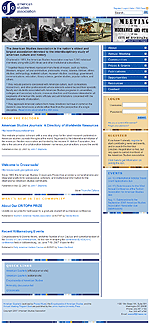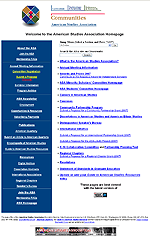 Hop Studios is really excited about the launch of our latest project: a redesign of the American Studies Association website. This was a huge overhaul, migrating an enormous number of flat files into a database, building in template efficiencies across the site, and even designing a new logo and look. The old site was put together in the very early days of the web—in fact, we’d go so far as to say the ASA was on the cutting edge when they first put up a website in the ‘90s. But like so many websites, the site grew. And grew. And grew.
Hop Studios is really excited about the launch of our latest project: a redesign of the American Studies Association website. This was a huge overhaul, migrating an enormous number of flat files into a database, building in template efficiencies across the site, and even designing a new logo and look. The old site was put together in the very early days of the web—in fact, we’d go so far as to say the ASA was on the cutting edge when they first put up a website in the ‘90s. But like so many websites, the site grew. And grew. And grew.
It grew way beyond its original design, and beyond its information architecture, and as time passed it started to look a lot like a list of links. At the same time, it became harder for the folks maintaining the site to know what was already there—and so duplication of content began to occur. So when the ASA decided they needed to redesign, our first task was to corral all this content. We did an extensive survey, made maps and charts and spreadsheets, and working with John Stephens, president of the ASA, decided what to keep and how to organize all that content. In the process, we realized we could make maintaining the site a lot easier in big and little ways.
For example, a big feature of the site are the dissertation abstracts. Since 1986, the ASA has kept an archive of dissertations in American Studies, and it has been an invaluable research tool for those in the field, and a big pain to maintain. Each year, staff has had to painstakingly compile alphabetical and date-based lists of abstracts by hand. And, while you could easily look up a dissertation by the author’s last name, finding the most recent abstracts or those from a particular school took a lot of clicking and reading. Now, thanks to the database behind the site, the ASA can slice and dice the dissertations several ways—alphabetically by author or title, by school, and by date—and with no extra work.
 The most exciting parts of the site, however, are the member directory and the community pages designed to be used by the projects, chapters, caucuses and committees of the ASA. Geographically, the ASA members get together only once a year as a group for their annual meeting. But the work of American Studies is year-round, and the need to collaborate is ongoing. Now, via the website, members of the ASA can contribute to blogs within community groups, build out an extensive profile, and find other members to work with by looking at expertise and research areas. Over time, the hope is that the site will make it possible for members to make new and exciting connections with each other. We can’t wait to see what they make of these new tools ourselves.
The most exciting parts of the site, however, are the member directory and the community pages designed to be used by the projects, chapters, caucuses and committees of the ASA. Geographically, the ASA members get together only once a year as a group for their annual meeting. But the work of American Studies is year-round, and the need to collaborate is ongoing. Now, via the website, members of the ASA can contribute to blogs within community groups, build out an extensive profile, and find other members to work with by looking at expertise and research areas. Over time, the hope is that the site will make it possible for members to make new and exciting connections with each other. We can’t wait to see what they make of these new tools ourselves.
Comments